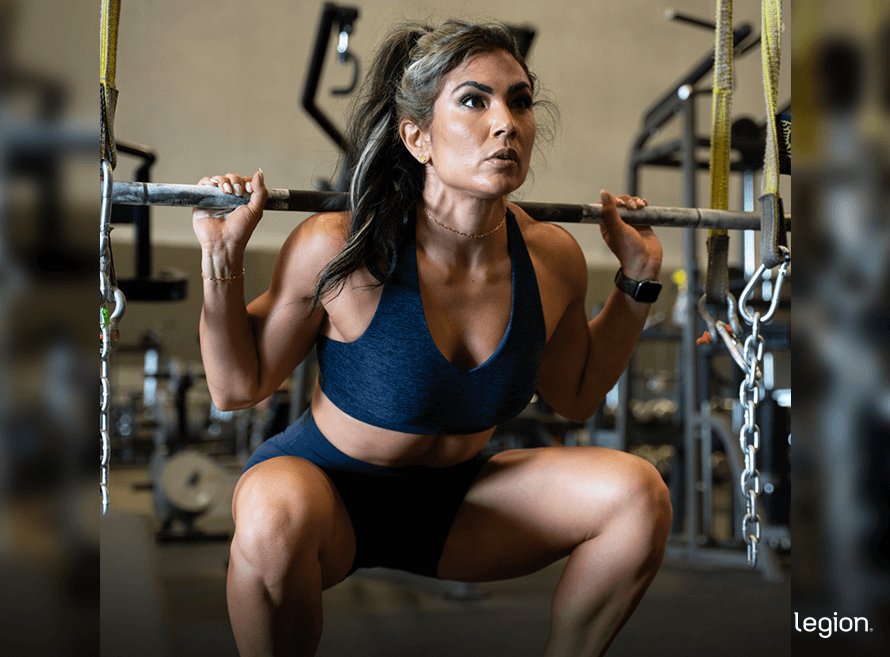
Most “mom butt” advice is built around one idea: pregnancy “ruins” your glutes.
That’s not really what’s happening.
In most cases, your butt looks flatter for boring reasons: your posture and movement change, your glutes get less training, and breastfeeding can shift where you lose fat.
None of that is permanent—but it also won’t fix itself.
This guide breaks down what’s actually going on and exactly how to rebuild a fuller, firmer butt after pregnancy.
Key Takeaways
- “Mom butt” (sometimes called “pancake butt”) is the flattening or loss of shape in the glutes that many women notice during or after pregnancy.
- Mom butt usually isn’t permanent, but it also won’t fix itself.
- The main drivers are changes in posture and movement, less physical activity, and (sometimes) shifts in fat distribution during breastfeeding.
- The fix is simple: train your glutes consistently, eat to support muscle growth, and stay mindful of your day-to-day posture.
- You don’t need supplements to fix your mom butt, but protein powder, creatine, and pre-workout can help you make gains faster.
Table of Contents
+
What Is “Mom Butt”?
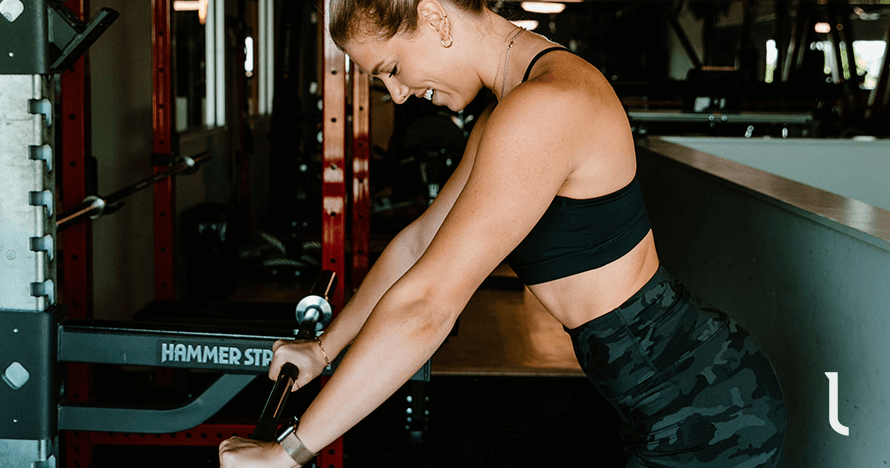
“Mom butt” (sometimes called “pancake butt”) is the flattening or loss of shape in the glutes that many women notice during or after pregnancy.
It’s not a medical diagnosis, and it’s not permanent—but it is common, and it usually won’t fix itself.
Why Mom Butt Happens After Pregnancy
Pregnancy and postpartum life can change posture, walking and running mechanics, and which muscles do the work as you move. And over time, this may change how your glutes look.
Posture and Movement Mechanics
As pregnancy progresses, your body’s weight shifts forward. Many women naturally adjust how they stand and move to feel steadier and more comfortable, and research shows this can change spinal curve, balance, and gait (walking pattern).
Here’s how that tends to look:
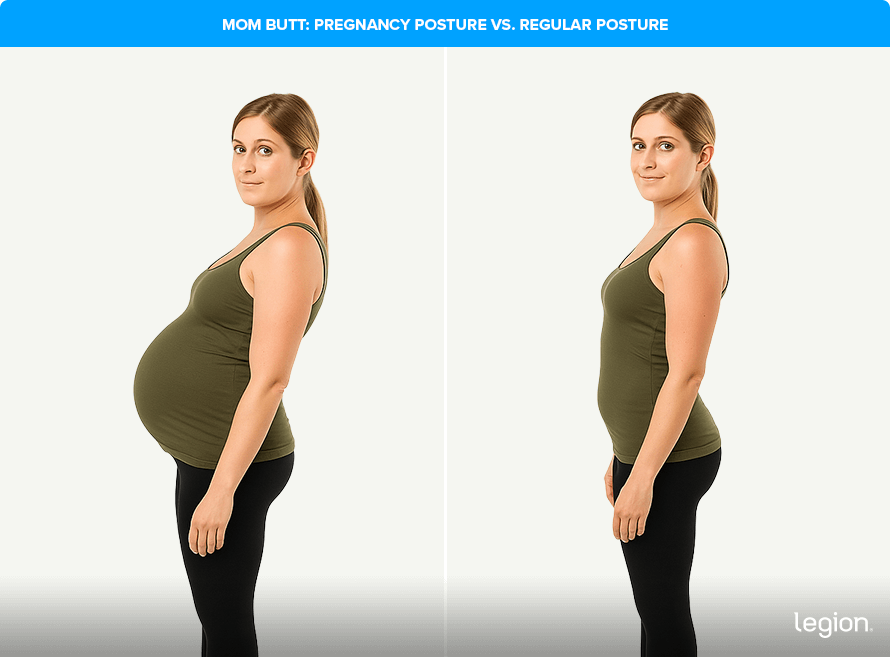
This posture may also mean your glutes contribute less to walking and running during pregnancy and postpartum compared with women who haven’t been pregnant.
And generally speaking, muscle shrinks when it isn’t used enough
So if your glutes . . .
- Get less work from daily movement and/or
- You aren’t training them consistently
. . . then it’s plausible they lose some size over time.
Breastfeeding
Breastfeeding burns a lot of energy, so your body often taps into stored fat to help cover the demand. Research shows that during lactation, fat can be mobilized from multiple areas of the body, including the hips and butt.
Where that fat comes off fastest depends a lot on your individual fat-loss patterns. So if you’re the type of person who leans out from your hips, thighs, and glutes first, you may notice your butt shrinks more during breastfeeding than you expected.
Inactivity
Pregnancy and postpartum life can be a perfect storm for less movement: you’re tired, your schedule is chaotic, and workouts often get bumped by more urgent things (like sleep).
When a muscle isn’t challenged regularly, it tends to shrink over time. So if you’re walking less, sitting more, and not doing consistent lower-body training for months, your glutes will likely lose some size and firmness.
Can Your Butt Go Back to Normal After Pregnancy?
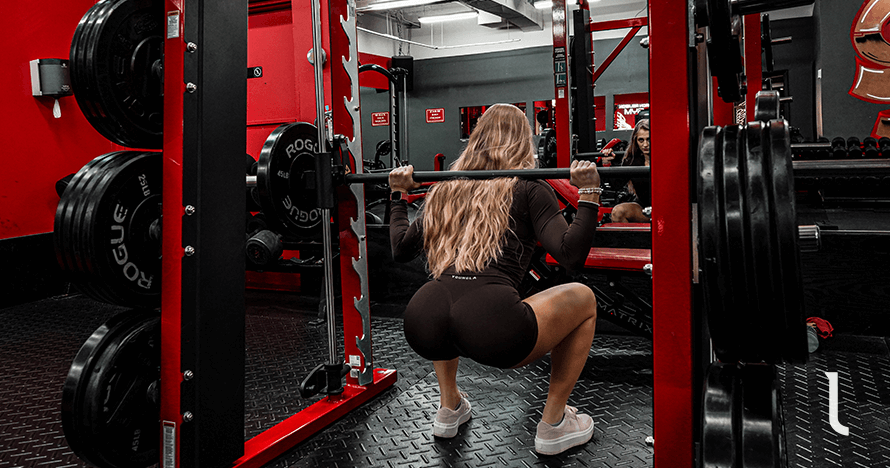
Mom butt usually isn’t permanent—but it also won’t fix itself.
After you give birth, your movement patterns often start returning to normal. That helps. But if you lost glute muscle during pregnancy and postpartum, everyday activity usually isn’t enough to rebuild it.
When you train your glutes consistently again, they can regain a lot of size, firmness, and shape.
Just keep expectations realistic: you may not look exactly like you did pre-pregnancy, but you can dramatically improve how your butt looks if you put in the work.
How to Fix Mom Butt (What Actually Works)
Fixing mommy butt comes down to three things: training your glutes hard enough to grow, eating in a way that supports muscle gain, and getting your day-to-day posture back into a better groove.
Exercise
If you want your butt to look fuller and firmer, you need to build muscle, and the most reliable way to do that is strength training.
A good target is two glute-focused strength workouts per week. That’s usually enough to train your glutes with the volume (sets) they need to grow without beating you up—especially if sleep and recovery aren’t perfect (which is . . . most postpartum life).
These workouts should emphasize glute training, but they shouldn’t be “glutes only.” You’ll get better results long-term if you also train the rest of your body so you don’t end up with muscle and strength imbalances (more on specifics soon).
Nutrition
Training gives your glutes the signal to grow. Your diet provides the materials to make it happen.
Exactly how you should eat depends on how long you’ve been strength training:
- New weightlifters: Eat 20–25% fewer calories than you burn every day. This is called a calorie deficit, and while it stymies muscle growth in experienced weightlifters, newbies are so responsive to training that it allows them to build muscle and lose fat simultaneously.
- Experienced weightlifters: After 6 months or more of consistent training, you must eat more calories than you burn to build muscle effectively. Aim for 110% of your total daily energy expenditure to maximize muscle growth while minimizing fat gain.
In both cases, macronutrients matter too. Here are some simple, effective guidelines:
- Protein: About 1 gram per pound of body weight per day
- Fat: About 20–30% of daily calories
- Carbs: The rest of your calories
To learn more about how many calories, how much of each macronutrient, and which foods you should eat to reach your goals, take the Legion Diet Quiz.
Posture
There’s no “perfect posture,” but being more “stacked” is a good way to think about it when you’re trying to get rid of mom butt: rib cage over hips, butt not tucked under, spine not overly arched.
When you’re carrying your child, standing, or walking, check in on your posture and correct it when needed. Just don’t overcorrect—pushing your chest out and cranking into an exaggerated arch can look just as awkward.
The Best Exercises for Getting Rid of Mom Butt
If you want your butt to look fuller and firmer, you need to build glute muscle. These lifts do that best because they let you train your glutes hard through big ranges of motion and keep progressing week to week.
Squat
Why: Lets you use heavy weights through a large range of motion, which helps build bigger, stronger glutes (and legs).
How to:
- Set a barbell in a rack at about chest height.
- Step under it, pinch your shoulder blades together, and rest the bar across your upper back.
- Lift the bar out, step back, and set your feet slightly wider than shoulder-width with your toes turned out.
- Keeping your back straight, sit down and push your knees out in the same direction as your toes.
- Reverse the movement and return to the starting position.
READ MORE: How to Do the Back Squat: Form, Benefits, and More
Goblet Squat
Why: A simple squat variation that makes it easy to hit depth and keep good form while still training the glutes hard.
How to:
- Hold a dumbbell in front of your chest with both hands.
- Place your feet a little wider than shoulder-width apart, point your toes slightly outward, and raise your chest.
- Keeping your back straight, sit down and push your knees out in the same direction as your toes.
- Stand up and return to the starting position.
READ MORE: Goblet Squat: Form, Form, Muscles Worked, & Common Mistakes
Bulgarian Split Squat
Why: Trains your glutes hard one leg at a time, which helps fix side-to-side imbalances.
How to:
- Hold a dumbbell in each hand and stand 2–3 feet in front of a bench.
- Place the top of your left foot on the bench behind you and keep your right heel planted.
- Lower your hips by bending your right knee until it’s at about 90 degrees.
- Reverse the movement and return to the starting position.
- Complete all reps on one side, then switch legs.
READ MORE: How to Perform Bulgarian Split Squats for Glutes, Hamstrings & Quad Growth
Deadlift
Why: Trains your entire backside with heavy weights, which is ideal for gaining muscles and strength.
How to:
- Stand with your feet slightly narrower than shoulder width, toes pointed slightly out.
- Position the bar over your midfoot, about an inch from your shins.
- Push your hips back and grip the bar just outside your legs.
- Take a deep breath, brace your core, and flatten your back.
- Drive through your heels to stand upright, keeping the bar close to your body.
- Reverse the movement and return to the starting position.
READ MORE: How to Deadlift with Proper Technique
Dumbbell Romanian Deadlift
Why: A simple “hinge” you can load and progress that trains your glutes through a big range of motion—without needing a barbell.
How to:
- Stand upright holding a dumbbell in each hand, palms facing your thighs.
- Push your hips backward and arch your lower back slightly.
- When you feel a stretch in your hamstrings, bend your knees slightly, and keep lowering the dumbbells until your back begins to round.
- Reverse the movement and return to the starting position.
READ MORE: How to Do the Romanian Deadlift: Form, Benefits, and Variations
Step-up
Why: Trains the glutes through a large range of motion and doesn’t require much weight to be effective, so it’s usually a little gentler on your joints.
How to:
- Holding a dumbbell in each hand, place your right foot on a box, bench, or other surface about knee-height off the floor.
- Keeping your weight on your right foot, fully straighten your right leg.
- Lower your left foot toward the floor, and return to the starting position.
READ MORE: Weighted Step-Ups Guide: How to Do Dumbbell Step-Ups
Hip Thrust
Why: The positioning of the barbell during hip thrusts forces your glutes to work hard throughout the entire range of motion, which is a unique benefit of this exercise.
How to:
- Sit on the ground with your shoulders against a bench.
- Roll a barbell over your thighs so it sits in your hip crease (use a bar pad for comfort).
- Plant your feet about shoulder-width apart and 12–18 inches from your butt so your knees are bent to about 90 degrees.
- Press through your heels to push the bar up until your upper body and thighs are parallel to the ground and your shins are vertical.
- Reverse the movement and return to the starting position.
READ MORE: How to Do the Barbell Hip Thrust: Form, Mistakes & Alternatives
Cable Hip Abduction
Why: Trains your glutes from a different angle to other exercises, which is important for overall growth.
How to:
- Attach an ankle cuff to a low cable and clip it around the ankle farthest from the machine.
- Stand sideways to the stack, hold something stable, and brace your core.
- Start with your working leg in front and across your body and your toes pointing forward.
- Sweep your leg out to the side without leaning or twisting your torso.
- Reverse the movement and return to the starting position.
Supplements to Help You Get Rid of Mom Butt
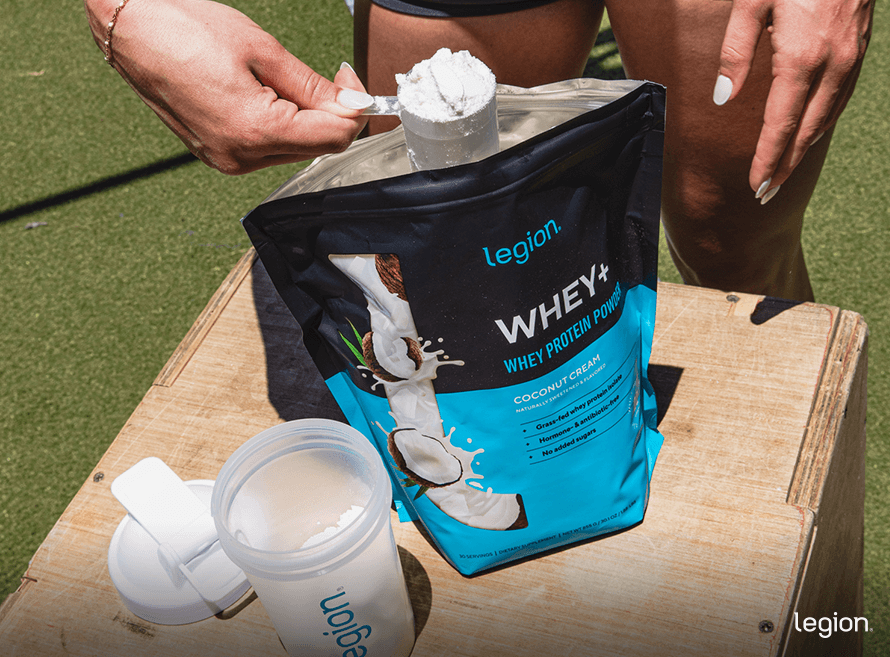
You don’t need supplements to fix mom butt, but the right ones can help. Here are three worth considering:
- Protein powder: Eating enough protein is essential for building lower body muscle. Protein powders like Whey+, Casein+, and Egg+ make hitting your target easier.
- Creatine: Creatine boosts muscle and strength gain, improves endurance, and reduces muscle damage and soreness. For a natural source of creatine, try Legion’s creatine monohydrate powder, creatine gummies, creatine capsules, or post-workout Recharge.
- Pre-workout: A quality pre-workout helps you train harder by boosting energy, focus, and athletic performance. Legion’s Pulse is available with or without caffeine.
Want even more specific supplement advice? Take the Legion Supplement Finder Quiz to learn exactly what supplements are right for you.
How Long Does It Take to Get Rid of a Flat or Saggy Butt?
If you follow the advice in this article, you should notice some change in how your mom butt looks within 8–12 weeks.
For bigger changes, you’re usually looking at 3–6 months of consistent effort.
The Bottom Line on Getting Rid of Mom Butt
Mom butt is common—and it’s usually not permanent. Pregnancy, breastfeeding, and early postpartum life can change how you move, how much your glutes work, and where you lose fat, which can make your butt look flatter.
The fix isn’t complicated: train your glutes consistently, eat in a way that supports muscle growth, and clean up your day-to-day posture. Do that, and most women can noticeably improve how their butt looks within a few months.
FAQ #1: Why has my butt gone flat after birth?
After pregnancy, your posture and movement patterns often change, and many women also move less and train less for a while. If your glutes aren’t being challenged much—either through daily activity or in workouts—they can lose some size and firmness over time.
Breastfeeding can also change body fat stores, which may make your butt look smaller if you tend to lose fat from your hips and glutes first.
FAQ #2: Will my butt go back to normal after pregnancy?
Often, yes—but it usually takes a deliberate rebuild. YAs postpartum life settles, your movement patterns usually start looking more like they did pre-pregnancy. That can help, but it usually isn’t enough to rebuild glute muscle if you lost a significant amount.
To get your butt back, you generally need consistent glute training. Do that, and most women regain a lot of size, firmness, and shape—even if it’s not perfectly identical to pre-pregnancy.
FAQ #3: Does your butt get bigger during pregnancy?
It can, but not always. Some women gain fat around the hips and glutes during pregnancy, which can make the butt look bigger. Others change how they stand and walk—often tucking the pelvis under a bit—which can make the butt look flatter even if body weight hasn’t changed much.
Either way, what you see during pregnancy doesn’t guarantee what your butt will look like postpartum—especially once activity, sleep, and training habits change.
Want More Content Like This?
Check out these articles:
- Can You Lift Weights While Pregnant? What Science Actually Says
- The Definitive Guide on How to Create a Pregnancy Meal Plan
- The Best Postpartum Workout Plan for Full-Body Strength
Scientific References +
- Conder, Rebecca, et al. “The Biomechanics of Pregnancy: A Systematic Review.” Journal of Functional Morphology and Kinesiology, vol. 4, no. 4, 2 Dec. 2019, p. 72, https://doi.org/10.3390/jfmk4040072.
- Bagwell, Jennifer J., et al. “Lower Extremity Kinetics and Muscle Activation during Gait Are Significantly Different during and after Pregnancy Compared to Nulliparous Females.” Gait & Posture, vol. 81, Sept. 2020, pp. 33–40, https://doi.org/10.1016/j.gaitpost.2020.07.002. Accessed 13 Apr. 2021.
- Bagwell, Jennifer J., et al. “Running Biomechanics Differ during and after Pregnancy Compared to Females Who Have Never Been Pregnant.” Gait & Posture, vol. 109, 1 Mar. 2024, pp. 277–283, www.sciencedirect.com/science/article/pii/S096663622400047X, https://doi.org/10.1016/j.gaitpost.2024.02.004. Accessed 17 Mar. 2024.
- Nunes, Everson A., et al. “Disuse-Induced Skeletal Muscle Atrophy in Disease and Nondisease States in Humans: Mechanisms, Prevention, and Recovery Strategies.” American Journal of Physiology-Cell Physiology, vol. 322, no. 6, 1 June 2022, pp. C1068–C1084, https://doi.org/10.1152/ajpcell.00425.2021.
- Kramer, F. M., et al. “Breast-Feeding Reduces Maternal Lower-Body Fat.” Journal of the American Dietetic Association, vol. 93, no. 4, 1 Apr. 1993, pp. 429–433, pubmed.ncbi.nlm.nih.gov/8454811/, https://doi.org/10.1016/0002-8223(93)92289-a. Accessed 26 Mar. 2023.
- Contreras, Bret, et al. “Barbell Hip Thrust.” Strength and Conditioning Journal, vol. 33, no. 5, Oct. 2011, pp. 58–61, https://doi.org/10.1519/ssc.0b013e31822fa09d.
- Eckerson, Joan M., et al. “Effect of Creatine Phosphate Supplementation on Anaerobic Working Capacity and Body Weight after Two and Six Days of Loading in Men and Women.” The Journal of Strength and Conditioning Research, vol. 19, no. 4, 2005, p. 756, https://doi.org/10.1519/r-16924.1.
- Bassit, Reinaldo Abunasser, et al. “Effect of Short-Term Creatine Supplementation on Markers of Skeletal Muscle Damage after Strenuous Contractile Activity.” European Journal of Applied Physiology, vol. 108, no. 5, 3 Dec. 2009, pp. 945–955, https://doi.org/10.1007/s00421-009-1305-1.










